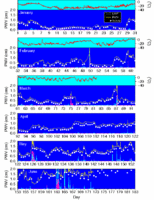Evaluation of Microwave Radiometer Performance in Alaska
Liljegren, J. C., Argonne National Laboratory
Atmospheric Thermodynamics and Vertical Structures
Cloud Properties, Radiative Processes
N/A
In order to determine the extent to which the ARM microwave radiometers would need to be modified to accommodate Arctic operations, an instrument designed for the Tropical Western Pacific was deployed at the University of Alaska at Fairbanks and continuously operated from 14 December 1995 through 20 June 1996 with the assistance of North Slope Site Scientist Knut Stamnes and Deputy Site Scientist Abdul Alkezweeny. Time series plots of the data are presented in Figure 1.
Time series of integrated or "precipitable" water vapor (PWV) and liquid water path (LWP) from the microwave radiometer. Periods of precipitation were detected by a moisture sensor on the radiometer and are indicated by vertical magenta bars. The circles indicate PWV derived by integrating the radiosondes. Ambient temperatures were acquired from a NEWNET monitoring station located near the radiometer by Los Alamos National Laboratory. The station was removed in mid-March 1996.
The test revealed that the thickness of the insulation in the tropical instrument was insufficient to ensure thermal stabilization at temperatures below -35°C. Figure 2 shows that the radiometer mixer temperature is clearly affected by low ambient temperatures. Radiometers acquired for Arctic operations have been equipped with substantially thicker insulation. However, no other significant modifications to the radiometer design were required.
Time series of radiometer mixer temperature and ambient air temperature. The mixer temperature should be within +/- 0.5 K of its setpoint (~323 K). Additional insulation will be used in Arctic radiometers.
National Weather Service soundings (using Vaisala RS-80 sondes) launched from the Fairbanks airport were acquired to develop monthly statistical retrievals of integrated or precipitable water vapor (PWV) and liquid water path (LWP) for the site. The soundings were also used to drive the NOAA/ETL model of microwave radiometric brightness temperatures for comparison with the instrument. The comparisons of measured and modeled brightness temperatures in Figures 3 and 4 reveal that the 31.4 GHz (liquid-sensing) channel is much more sensitive to the thermal stabilization than is the 23.8 GHz (vapor-sensing) channel. Consequently, the comparison of PWV from the sondes and the radiometer in Figure 5 does not appear to be affected by the thermal stabilization problem. The sondes reported less water vapor than the radiometer, consistent with other comparisons at the SGP and MCTEX.
Measured and modeled 31.4 GHz brightness temperatures for January-February, March-April, and May-June. Clear sky cases only. The effect of inadequate thermal stabilization is evident.
Measured and modeled 23.8 GHz brightness temperatures for January-February, March-April, and May-June. Clear sky cases only. Any effects of inadequate thermal stabilization are difficult to discern.
PWV from soundings compared with radiometer retrievals for January-February, March-April, and May-June. All cases (non-precipitating.) Soundings consistently indicate less moisture than the radiometer.
High-quality measurements of integrated water vapor and cloud liquid water were made in an Arctic environment at Fairbanks using an ARM microwave radiometer.
The radiometer thermal stabilization was affected by extreme cold temperatures because the insulation thickness was chosen for tropical operations. Additional insulation will be used on radiometers built for the Arctic.
The sondes reported approximately 10% less water vapor than the microwave radiometer, a fact that is consistent with comparisons at MCTEX and the ARM SGP CART.

















